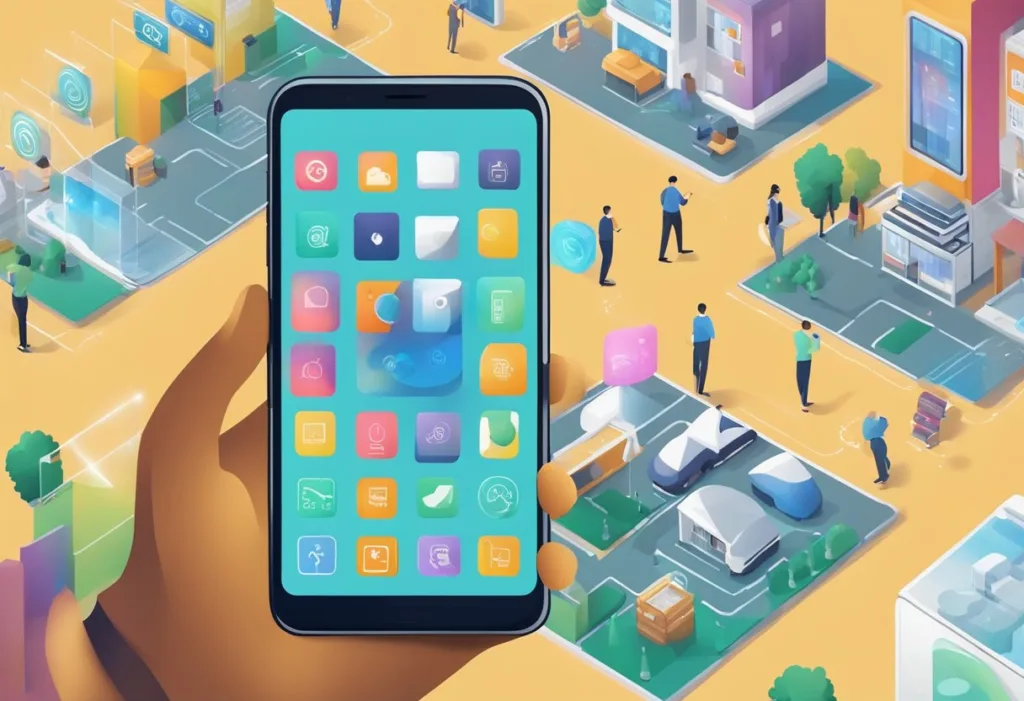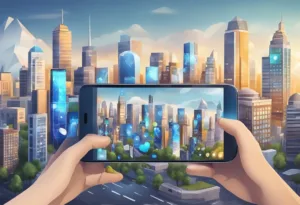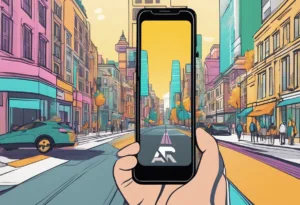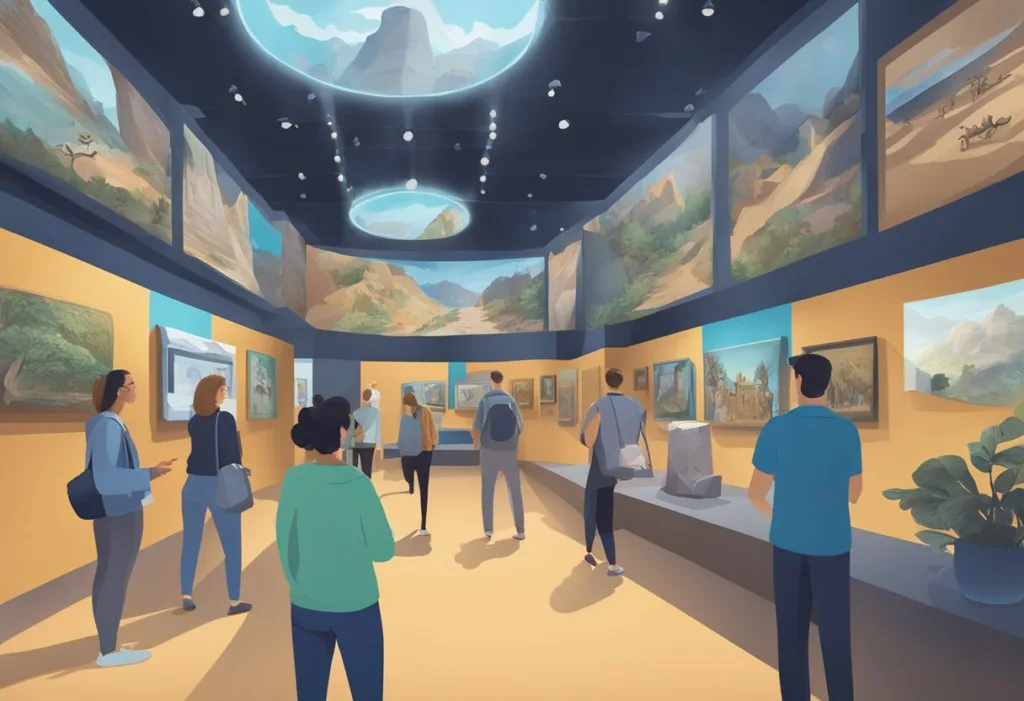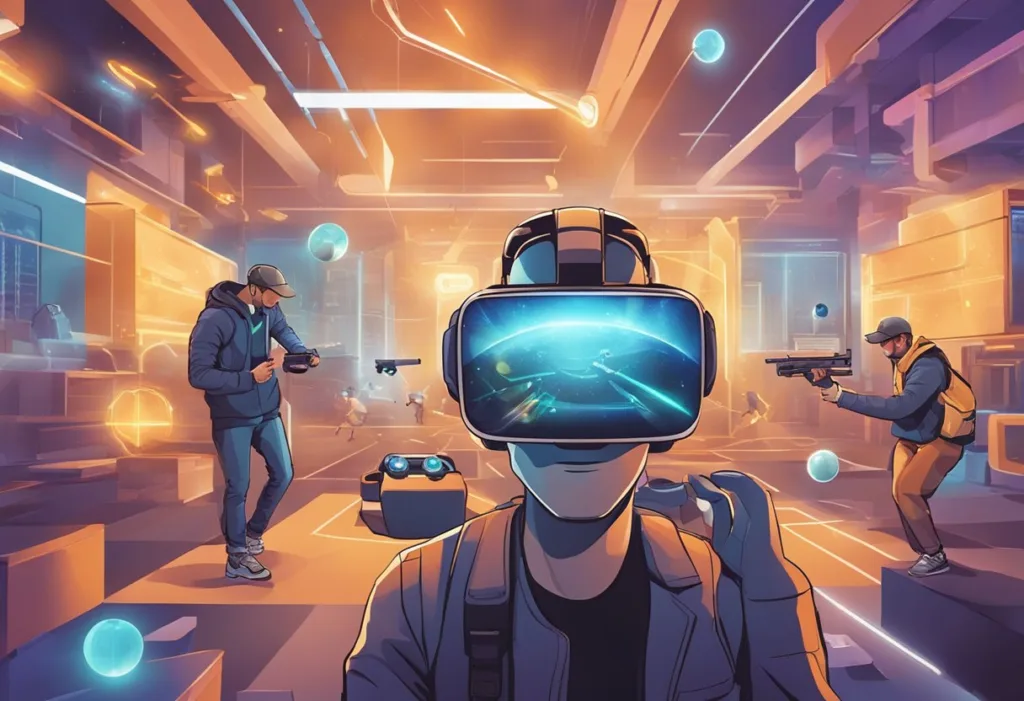Augmented reality (AR) is an emerging trend within marketing and sales strategies, one that allows brands to give their customers unique experiences with the convenience of tapping into their mobile devices. The technology is rapidly advancing, with new AR-enabled devices and apps being developed every day. In this blog post, I will share with you 15 use cases of AR for marketing and how you can apply these use cases to your marketing project.
AR for marketing is about creating an interactive experience that allows customers to engage with your brand in a new and exciting way. It is a way to bring your products and services to life and create a more engaging and memorable experience for your customers. With AR, you can create virtual showrooms, product demos, and interactive games that allow customers to experience your brand in a whole new way.
What is AR marketing?
AR marketing is the use of AR technology to create marketing campaigns that engage customers in new and exciting ways. AR marketing campaigns can be used to create interactive experiences, provide product information, and even allow customers to try products before they buy them. By using AR, businesses can create a unique and memorable experience for their customers, which can help to build brand loyalty and increase sales.
15 Use Cases Of AR For Marketing
Here’s are 15 use cases of AR for marketing:
- Virtual Try-On
- Interactive Billboards
- AR in Print Media
- Product Demonstrations
- Immersive Brand Storytelling
- Gamified Shopping Experiences
- AR-Enabled Event Activations
- Location-Based Promotions
- AR in Social Media Filters and Lenses
- Educational Content for Products
- Virtual Storefronts and Showrooms
- Personalized Recommendations
- Packaging as a Portal to AR
- AR for Navigation in Retail Spaces
- Data Visualization and Analytics
Virtual Try-On
Virtual Try-On is a powerful tool in the marketing arsenal, allowing customers to visualize products on themselves before making a purchase. This is particularly effective in the beauty and fashion industries. For instance, Sephora’s Virtual Artist app lets customers try on various makeup products, and Warby Parker’s app allows users to see how different eyeglass frames would look on their face. These AR experiences enhance customer engagement and can lead to increased conversion rates by providing a more confident buying decision for online shoppers.
Interactive Billboards
Interactive billboards take outdoor advertising to a new level by engaging passersby with AR content that can be accessed via smartphones. Pepsi MAX’s “Unbelievable” bus shelter campaign transformed a simple ad space into an interactive experience, while McDonald’s created billboards that users could interact with to play a game and win prizes. These innovative uses of AR create memorable experiences that can increase brand awareness and encourage social sharing.
AR in Print Media
Augmented Reality has revitalized print media by allowing readers to access digital content through their physical magazines or newspapers. National Geographic has used AR to bring its articles to life, providing readers with immersive content like 3D animations and videos. Similarly, IKEA’s catalog app lets users place virtual furniture in their homes directly from the catalog, merging the tactile appeal of print with the convenience of digital technology.
Product Demonstrations
AR enables companies to demonstrate products in a highly detailed and interactive way that was previously impossible. For example, Hyundai’s AR manual allows car owners to learn about their vehicle’s features using their smartphone. Bosch has also utilized AR to demonstrate the complexities of their appliances, giving customers a deeper understanding of the product’s functionality and benefits.
Immersive Brand Storytelling
Brands are using AR to tell their stories in a more engaging and immersive manner. For instance, Patrón Tequila created an AR experience that takes users on a virtual tour of their distillery, offering a behind-the-scenes look at how their product is made. Jack Daniel’s also launched an AR app that narrates the history of the whiskey, turning each bottle into a storytelling device.
Gamified Shopping Experiences
Gamification through AR can make shopping more fun and interactive. Timberland created a virtual fitting room where customers could see themselves in different outfits without physically trying them on. LEGO has also embraced AR by allowing customers to see a 3D model of the constructed set just by scanning the box, making the shopping experience more engaging and informative.
AR-Enabled Event Activations
Events can be enhanced with AR to create unique and memorable experiences for attendees. At Comic-Con, Marvel used AR to bring their comic book covers to life, while Disney has created AR treasure hunts at its parks, providing an interactive layer to the visitor experience and encouraging exploration.
Location-Based Promotions
Location-based AR promotions can drive foot traffic to physical stores by offering exclusive content or discounts to users in specific locations. Starbucks has experimented with AR games that can be played in-store, offering rewards for participation. Similarly, Burger King has used geolocation to provide special offers to customers near their restaurants.
AR in Social Media Filters and Lenses
Social media platforms like Snapchat and Instagram offer AR filters and lenses that brands can customize for marketing campaigns. Taco Bell created a Cinco de Mayo-themed lens on Snapchat, which was a massive hit among users. L’Oréal also leverages Instagram filters to allow users to try on makeup, effectively turning a social media interaction into a virtual product sample.
Educational Content for Products
AR can educate consumers about products in an interactive manner. For instance, Gatorade created an AR game that teaches users about the importance of staying hydrated. Mondelēz International, the parent company of Oreo, has used AR to provide educational games on product packages, teaching children about the brand in a fun way.
Virtual Storefronts and Showrooms
Companies are creating virtual storefronts and showrooms to showcase their products. Audi has implemented AR to provide customers with a virtual tour of their cars, allowing for a detailed inspection of features and customizations. Similarly, Ralph Lauren has used AR to create a virtual window shopping experience, where users can view collections and access product information.
Personalized Recommendations
AR can offer personalized product recommendations based on user preferences or past behavior. For example, Amazon’s AR View helps customers visualize products in their own space, which can also suggest items that complement their existing decor. Nike’s app provides AR shoe recommendations by analyzing the user’s foot structure and gait.
Packaging as a Portal to AR
Brands are turning their packaging into gateways for AR experiences. Coca-Cola has created AR-enabled packaging that, when scanned, reveals brand stories and games. Similarly, 19 Crimes wine uses AR to bring the stories of the convicts featured on their labels to life, providing a unique narrative experience with each bottle.
AR for Navigation in Retail Spaces
AR can assist customers in navigating large retail spaces. Home improvement stores like Lowe’s have tested AR apps to help customers find products in their vast stores. Similarly, Walmart has experimented with AR for in-store navigation, making it easier for customers to locate items on their shopping list.
Data Visualization and Analytics
Data visualization using AR can provide insights in a more digestible and interactive format. For example, SAP has used AR to visualize complex business data for their clients, helping them understand patterns and trends. Salesforce has also incorporated AR into their CRM platform, enabling sales representatives to visualize and interact with sales data in real time.
AR marketing examples
AR marketing has been used in a variety of ways, from product launches to creating interactive posters. Here are some examples of AR marketing campaigns:
- IKEA Place: IKEA created an AR app that allows customers to see how furniture would look in their home before they buy it. This app has been a huge success, with over 8 million downloads to date.
- Pepsi Max: Pepsi Max created an AR campaign that allowed customers to play a virtual game of football with their favorite players. This campaign was a huge success, with over 1 million interactions in just two weeks.
- Pokemon Go: Pokemon Go is a game that uses AR technology to allow players to catch virtual Pokemon in the real world. This game was a massive success, with over 1 billion downloads to date.
Strategies for AR Marketing
Augmented Reality (AR) technology is an excellent tool for creating immersive brand experiences. By leveraging AR, you can create an interactive and engaging experience that will leave a lasting impression on your customers. In this section, we will explore two key strategies for AR marketing that can help you make the most of this technology.
Creating Immersive Brand Experiences
One of the most significant benefits of AR marketing is the ability to create immersive brand experiences. By using AR, you can create interactive and engaging experiences that allow your customers to engage with your brand in a new and exciting way. For example, you can create an AR campaign that allows customers to try on clothes virtually or see how furniture will look in their home.
To create an immersive experience, you need to think carefully about how you can use AR to enhance your brand’s message. Think about what your customers want to see and how you can use AR to deliver it. Remember, an immersive experience is not just about the technology; it’s about the story you tell and the emotions you evoke.
Leveraging Social Media Platforms
Social media platforms are an excellent way to reach a large audience with your AR marketing campaign. By leveraging social media, you can create shareable content that will help your brand reach a wider audience. For example, you can create an AR filter that allows users to try on your products and share their experience with their friends.
When creating AR content for social media, it’s essential to keep in mind the platform’s requirements and limitations. For example, Instagram has specific guidelines for AR filters, and you need to ensure that your filter meets these guidelines. You need to think about how your AR content will fit into the user’s social media feed and how you can encourage them to share it.
AR technology has the potential to revolutionize the way we market our brands. By creating immersive experiences and leveraging social media platforms, you can use AR to engage with your customers in a new and exciting way. With the right strategy and execution, AR marketing can help you stand out from the competition and create a lasting impression on your customers.
AR in Retail and E-Commerce
As retailers and e-commerce businesses continue to compete for customers, they are turning to emerging technologies like augmented reality (AR) to enrich the relationships between consumers and brands. AR has quickly become a core element of marketing and retail strategies, as nine out of ten brands prepare to cater to the 3.5 billion users that are projected by 2022.
Virtual Try-On Solutions
One of the most popular applications of AR in retail is the virtual fitting room. With virtual try-on solutions, customers can easily see how clothing items or accessories will look on them without ever having to leave their homes. This technology can help reduce the number of returns and increase customer satisfaction, as shoppers can make better-informed decisions about their purchases.
For instance, IKEA has an AR app that allows customers to preview furniture and products in their homes before making a purchase. This feature helps customers visualize how a product will look in their space, which can increase their confidence in making a purchase.
Enhancing Online Shopping
AR is also being used to enhance the online shopping experience. By using AR, retailers can create more immersive and interactive shopping experiences for their customers. For example, Amazon has an AR feature that allows customers to see how certain products will look in their homes before making a purchase.
AR is also being used to create virtual storefronts, where customers can browse and purchase products in a virtual environment. This technology can help retailers reach customers who may not have access to physical stores, and it can also help reduce the costs associated with maintaining a physical storefront.
AR is changing the way retailers and e-commerce businesses interact with their customers. By using AR, businesses can create more immersive and interactive shopping experiences, which can lead to increased customer satisfaction and loyalty. As the technology continues to evolve, we can expect to see even more innovative applications of AR in the retail and e-commerce industries.
Case Studies and Successful AR marketing Campaigns

AR has proven to be a powerful tool for marketing, and many brands have successfully leveraged this technology to enhance their customer experiences and increase brand value. Here are two examples of successful AR campaigns:
Sephora’s Virtual Makeup
Sephora is a beauty retailer that has successfully integrated AR technology into its customer experience. The company’s Virtual Artist app allows customers to try on makeup virtually before making a purchase. The app uses facial recognition technology to map the customer’s face and apply makeup in real-time. Customers can try on different shades of lipstick, eyeshadow, and other products, and then purchase the products they like directly from the app.
This AR experience has been a huge success for Sephora. It has increased customer engagement and satisfaction, and has also helped to drive sales. Customers are more likely to purchase products they have tried on virtually, and the app has also helped to reduce the number of returns.
IKEA’s Furniture Placement App
IKEA is a furniture retailer that has also successfully integrated AR technology into its customer experience. The company’s Furniture Placement app allows customers to see how furniture would look in their homes before making a purchase. Customers can use the app to place virtual furniture in their rooms and see how it looks from different angles.
This AR experience has been a huge success for IKEA. It has increased customer engagement and satisfaction, and has also helped to drive sales. Customers are more likely to purchase products they have seen virtually in their own homes, and the app has also helped to reduce the number of returns.
These two examples show how AR experiences can be used to enhance customer experiences and increase brand value. By leveraging AR technology, brands can create immersive experiences that engage customers and drive sales.
Challenges and Considerations in AR
Augmented Reality (AR) is a cutting-edge technology that has the potential to revolutionize the marketing industry. However, implementing AR in marketing campaigns can be challenging. In this section, we will discuss some of the challenges and considerations that you should keep in mind when using AR for marketing.
Measuring ROI and Impact
One of the biggest challenges of using AR for marketing is measuring its return on investment (ROI) and impact. Measuring the effectiveness of AR campaigns can be difficult because there are no established metrics for this technology. Therefore, it is important to define clear goals and objectives before investing in AR technology. You should also track user engagement and behavior to measure the impact of your AR campaigns.
Technical and Financial Hurdles
Another challenge of using AR for marketing is the technical and financial hurdles. Implementing AR technology can be expensive, and it requires specialized skills and expertise. You may need to invest in new hardware and software, and you may also need to hire additional staff to manage your AR campaigns. Creating high-quality AR content can be time-consuming and costly.
To overcome these challenges, you should carefully consider the costs and benefits of using AR for marketing. You should also work with experienced AR developers and designers who can help you create engaging and effective AR campaigns. Finally, you should ensure that your AR campaigns are compatible with a wide range of devices and platforms to maximize their reach and impact.
Using AR for marketing can be challenging, but it can also be incredibly rewarding. By understanding the challenges and considerations involved in using AR for marketing, you can create effective and engaging campaigns that capture the attention of your target audience.
Frequently Asked Questions
How can augmented reality enhance marketing strategies?
Augmented Reality (AR) can enhance marketing strategies by providing a more immersive and interactive experience for customers. AR can be used to create engaging and personalized experiences that can enhance brand awareness, increase customer engagement, and drive sales. By using AR, marketers can create a unique and memorable experience for their customers that can help them stand out from their competitors.
Which industries are effectively incorporating AR into their marketing efforts?
Industries such as retail, e-commerce, automotive, and entertainment are effectively incorporating AR into their marketing efforts. Retailers are using AR to create virtual try-on experiences for their customers, while automotive companies are using AR to showcase their vehicles in a more interactive way. E-commerce companies are using AR to create virtual showrooms, and entertainment companies are using AR to enhance the user experience of their products.
What are some successful case studies of AR in marketing?
One successful case study of AR in marketing is the IKEA Place app, which allows customers to see how furniture will look in their homes before making a purchase. Another successful case study is the Pepsi Max AR campaign, which used AR to create a virtual soccer game that customers could play in real-time. The campaign resulted in a 7.5% increase in sales for Pepsi Max.
What are the potential drawbacks of using augmented reality in marketing campaigns?
One potential drawback of using AR in marketing campaigns is that it can be expensive to develop and implement. Some customers may not have access to the necessary technology to use AR, which can limit the reach of the campaign. Finally, if the AR experience is not well-designed or executed, it can lead to a negative customer experience.
How does AR compare to VR in terms of marketing applications?
AR and VR both have unique strengths and weaknesses when it comes to marketing applications. AR is better suited for creating interactive and immersive experiences that customers can engage with in the real world, while VR is better suited for creating fully immersive experiences that transport customers to a completely virtual environment. Ultimately, the choice between AR and VR will depend on the specific marketing goals of the campaign.
What are the future trends for AR technology in the marketing sector?
The future trends for AR technology in the marketing sector include the use of AR in social media platforms, the integration of AR with voice assistants, and the development of more advanced AR hardware. As AR technology becomes more accessible and affordable, we can expect to see more companies incorporating AR into their marketing strategies to create unique and engaging experiences for their customers.

